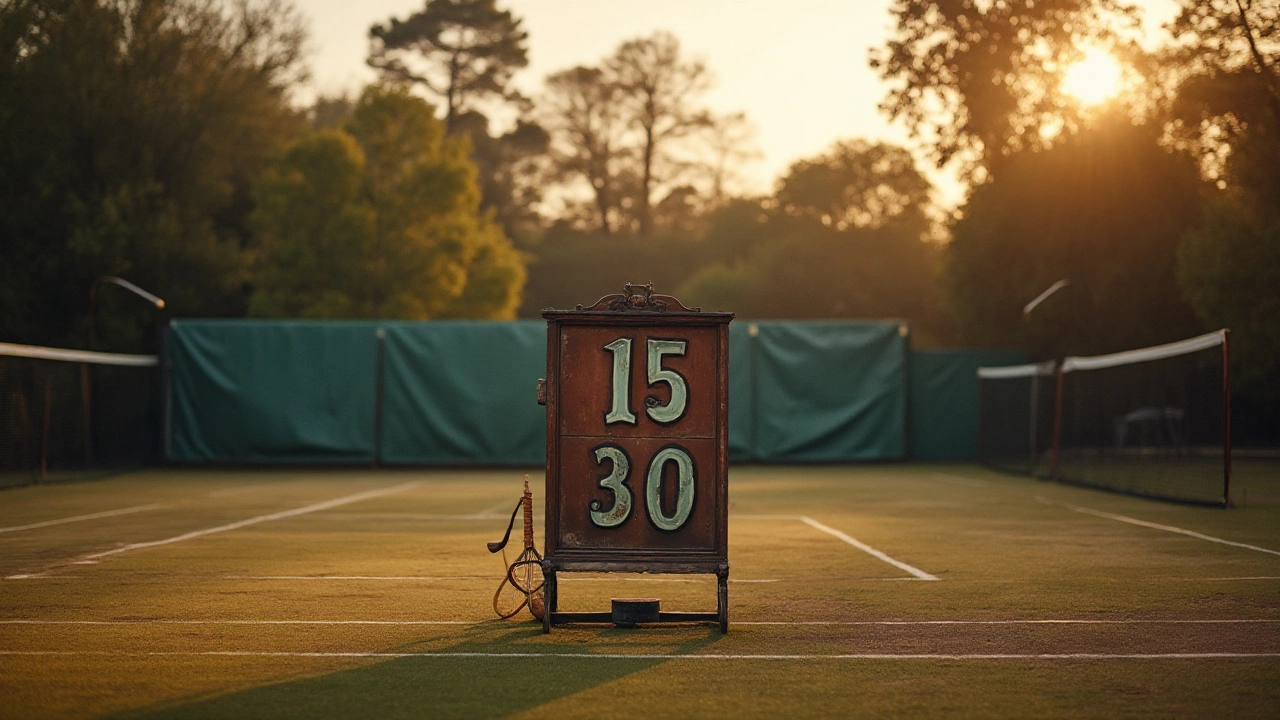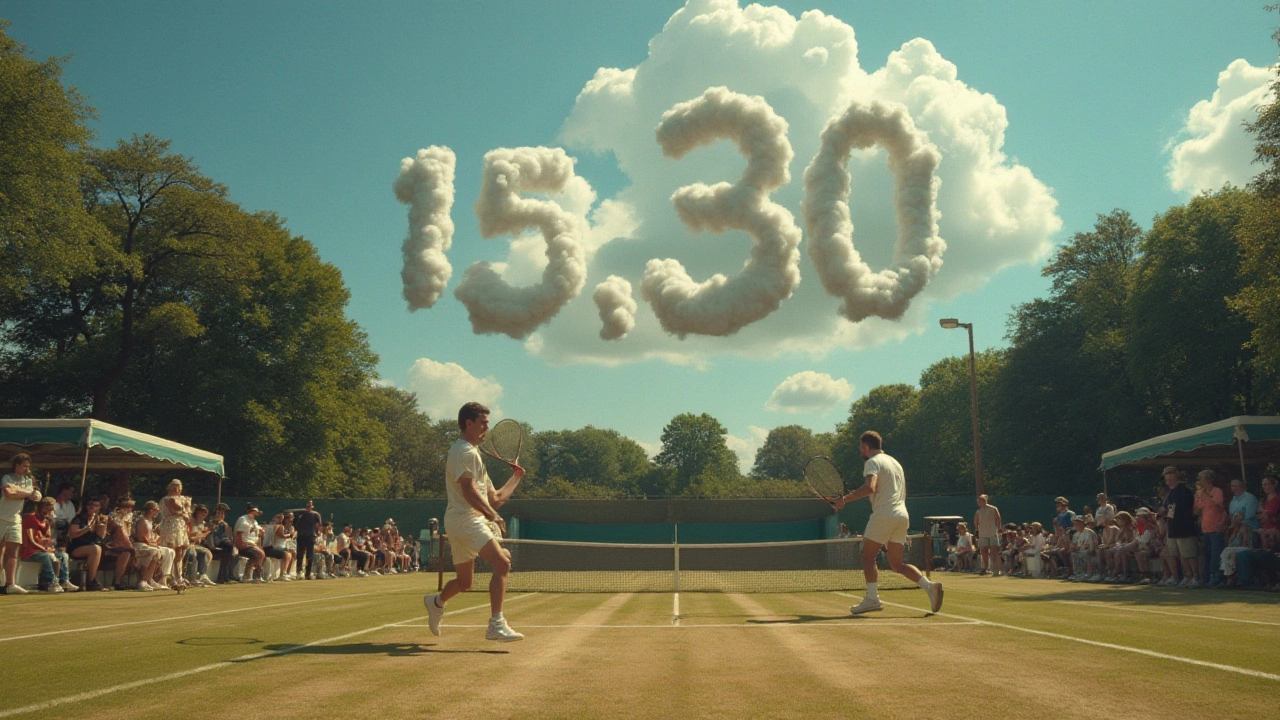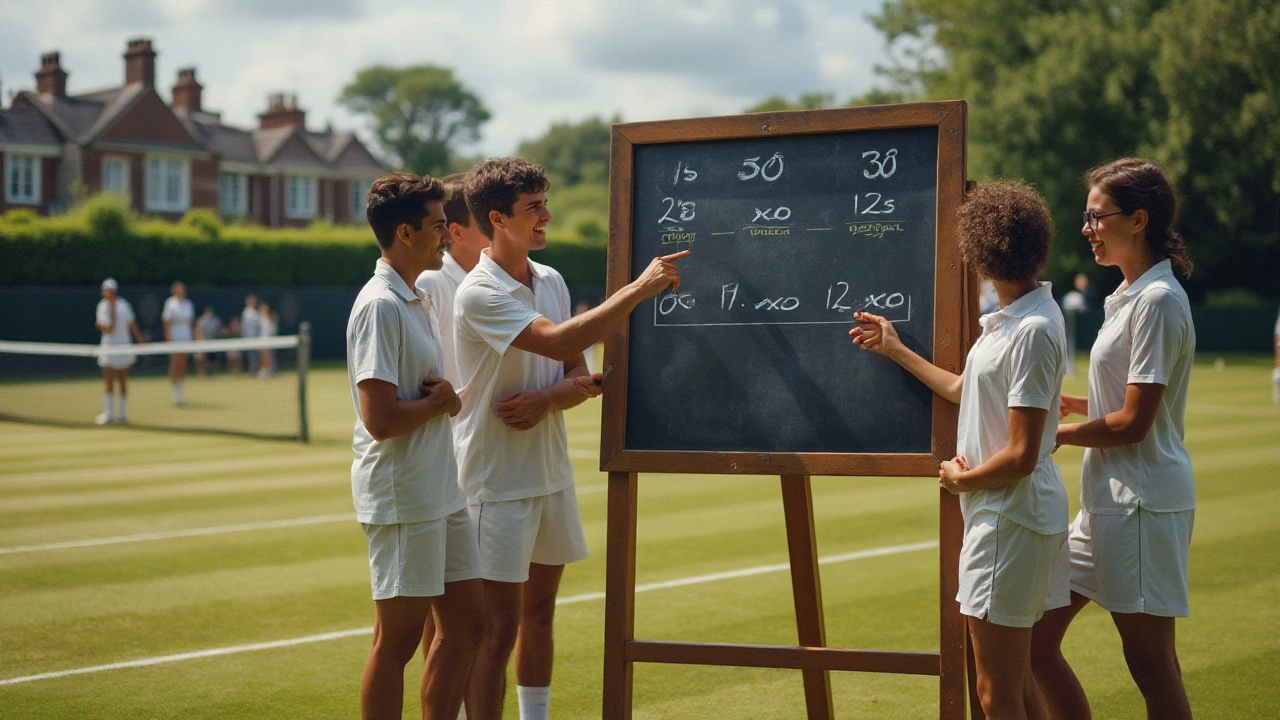Understanding Tennis Scoring: The Significance of 15 and 30
 Dec, 10 2024
Dec, 10 2024
Tennis scoring is one of those quirks that sets the sport apart, with its unique system that features seemingly arbitrary numbers. Among these, the points '15' and '30' stand out, often leaving spectators scratching their heads. Have you ever wondered why winning the first two points in a game doesn't simply tally up to '1' and '2'?
It's all rooted in history. Tennis scoring likely evolved from medieval clock faces used for gambling purposes. This peculiar system has persisted over centuries, continuing to shape not only the flow of the game but also the strategies employed by players worldwide. While the numbers might seem arbitrary, their influence on match pacing and mental play is significant.
Understanding 15 and 30 is key to appreciating both the nuances of tennis matches and the rich tapestry of tradition within the sport. Whether you're a budding fan or a seasoned player, delving into these origins can enrich your love for the game and enhance your tennis discussions.
- Origins of Tennis Scoring
- The Role of 15 and 30
- Game Strategy and Point Importance
- Cultural Impact on Tennis
Origins of Tennis Scoring
The intricate dance of a tennis scoring system, with its distinctive numbers like 15 and 30, can be traced back to the hallowed grounds of medieval Europe. This scoring system, as peculiar and mystifying as it seems, holds roots in a time when clocks were not just devices to tell the time but pivotal instruments in the world of wagering. In early forms of the game, which was a far cry from today's lawn tennis, French nobles would play with their servants in sprawling courtyards. As the games grew in popularity among aristocrats, an intriguing method of scoring using the face of a clock emerged.
Historians have long posited that the clock face was a practical means of tracking scores using the quarters of an hour: 15, 30, 45 (which was eventually abbreviated to 40), and so on. This could have stemmed from the fact that many contests during those times were wagered games, and the clock method offered both a convenient and readily available scoring device for gamblers. Further reinforcing this clock face theory are artifacts and paintings from that era, which depict early games with grand clock towers overseeing the commotion. In fact, early tennis players might have physically moved the hands of a clock to register their progress in the game. This scoring evolution is believed to have migrated across Europe and been adapted by the British, leading to the modern lawn tennis we recognize today.
The term 'love,' indicating zero, is believed to stem from the French word ‘l'oeuf,’ meaning egg, symbolizing how the zero resembled an egg's shape. This terminology perpetuates tennis's linguistic journey through time, blending the whimsical with practicality. In an old issue of "The Journal of Sport History," it is noted that "Scoring in tennis has long fascinated those interested in cultural anthropology.” The scoring system, steeped in mystery and speculation, has become an indispensable part of the sport's heritage. While the original reasons for these specific numerical choices might be shrouded in some ambiguity, fans and players alike embrace their enigmatic charm as part of the greater tapestry that makes tennis unique.
To add to this, it's fascinating to note that in the 19th century, when tennis became more standardized, particularly with the establishment of The All England Lawn Tennis and Croquet Club, the scores of 15, 30, and 40 became integral, even as standardized equipment and clothing were introduced. An anecdote often cited involves Charles James Middlefott, a well-respected sports historian, who joked in his writings that "A tennis score rolls off the tongue awkwardly, but there's a peculiar music to its dance.” Whether the journey of tennis scoring from medieval clocks to modern-day scoreboards was smooth or erratic, it is ripe with historical anecdotes and cultural imprints that echo through each serve and volley seen on courts today.

The Role of 15 and 30
The unique scoring system of tennis, marked by increments such as 15 and 30, is more than just an oddity that confuses newcomers; it plays a significant part in the dynamics and strategy of the game. The numbering might seem arbitrary at first glance, but it actually provides a rhythm and structure that both players and fans have come to appreciate deeply. Historically, as tennis evolved, these numbers became integral, influencing how matches unfold and how players strategize their games.
The point system starts at love, progresses through the sequential '15', '30', '40', and then potentially to the 'Game' point. This progression doesn’t just mark a player’s journey towards winning a game; it serves as a psychological battlefield. Each point value acts as a milestone. Winning that first '15' gives a player the initial advantage, setting the tone and often determining the tempo of play. The subsequent '30' denotes a critical pivot point. With two points on the scoreboard, a player positions themselves just a step away from an advantage, compelling both individuals to reassess their strategies and composure.
In essence, the scoring isn’t merely about reaching a threshold; it’s about the mental challenges these numbers present. Strategies revolve around breaking serve, and holding serve can hinge on these pivotal points. As one coach insightfully stated in an interview:
The 15 and 30 marks in tennis are like the corners in boxing; they define the territory and momentum. Each corner gives a fighter, or in this case, a tennis player, a chance to regroup and strategize.This quote encapsulates the strategic pauses that numbers like 15 and 30 represent. They prompt players to shift tactics mid-game and can dramatically alter the course of a match.
Moreover, if we consider some data, the significance of these points becomes apparent. Historical match analyses have demonstrated that players who repeatedly secure the '15' and '30' points have a statistically significant higher chance of winning games. For example, in a review of Grand Slam matches, players leading by 30-0 immediately displayed over 60% chance to secure the game—before any breaching opponent resistance. Such statistics foreground the conceptual weight these points carry, reinforcing the importance of these early scores in competitive play.
Understanding the role of 15 and 30 thus enhances both strategic preparation and in-game adaptability. These scores aren’t arbitrary metrics but foundational to how each player approaches the net with precision and intent. So next time you watch or play a match, consider that behind each '15' and '30' lies not just numbers, but a carefully crafted pathway of tactics and performance dynamics, resonating with the legacy of tennis itself.

Game Strategy and Point Importance
In tennis, every point stands crucial in potentially swinging the momentum of a match, but the points marked as 15 and 30 hold a nuanced significance that layers into strategic gameplay. Though they represent only the initial stages of a game, how a player navigates these points can mentally and tactically set the tone. At this stage, establishing an early lead or making a comeback can hinge on understanding the value of each point beyond the numbers on the scoreboard.
Players often approach the start of a game with a strategy shaped not just by their own strengths but by their evaluations of their opponent's weaknesses. Winning the first point offers a psychological edge, placing pressure on the opponent. The momentum gained from securing these early points can be a tactical weapon. For example, serving becomes crucial as players attempt to land their first serves effectively to create opportunities with returns that place opponents on the defensive.
Points and Psychological Games
From a psychological perspective, consistency during these phases helps in grounding a player's game before reaching more critical thresholds like 'deuce' or 'advantage'. According to tennis analyst Craig O'Shannessy, "locking down the first three points sets the framework from which potential exploits can be expanded." Players focus on maintaining low unforced error counts during these points, as conceding them easily can affect morale.
Strategically, knowing when to mix up shots — integrating slices, lobs, and volleys — can unsettle an opponent who might be anticipating a baseline exchange. This strategy is crucial when tied at such scores, as varying the playstyle makes it challenging for the opponent to settle into a rhythm. Coaches often emphasize training regimens that simulate pressure scenarios with a focus on the 15-30 points, ensuring players are both mentally and physically prepared.
Mike Bryan, of the legendary Bryan Brothers duo, once said, "The point of 30 is the crossroads; you can either blaze through or find yourself at the corner of challenge and change."
Statistics back the importance of these foundational points. A study conducted during Grand Slam tournaments revealed that players who win the initial two points (to reach 30) after their opponent has won the first point frequently win the game 58% of the time. This shows the substantive effect that early tactical and psychological pressure can induce on later stages of the game.
Hence, mastering the importance of 15 and 30 points isn't just about scoring, it's about dictating play tempo, managing the mental battlefield, and seizing opportunities. Those who do so effectively often find themselves better positioned as the game progresses, making these early points a critical part of crafting a successful overall match strategy.

Cultural Impact on Tennis
Tennis, with its unique scoring system, has left an indelible mark on culture, inspiring everything from artworks to fashion trends and even idiomatic expressions. Reflecting on how such a system influences the cultural landscape brings us closer to understanding the sport's global reach. For instance, the term "love" in tennis, representing a zero score, captivates many with its poetic interpretation, believed to derive from the French word "l'oeuf," meaning egg, symbolizing the shape of zero.
Tennis scoring, including the seemingly odd numbers like 15 and 30, has become a symbol of strategic thinking and elegance. These scores are not just points but part of a grander spectacle seen in historical tournaments globally. Arthur Ashe, the first African American to win a major tennis tournament, once remarked on the sport's capacity to "create change" beyond the court.
"From what we get, we can make a living; what we give, however, makes a life." – Arthur AsheThis idea of giving enriches not just the players but also the broader community, where tennis events drive cultural dialogues and foster international camaraderie.
Beyond the professional realm, the scoring system influences recreational players' experiences, transforming tennis matches into social and cultural gatherings at clubs and parks worldwide. These games are often interwoven with social events, enhancing community ties through casual matches and local championships. Tennis's influence on fashion can't be overlooked either, with its classic attire making waves both on and off the court, epitomizing a blend of tradition and modernity.
The persistent use of these numbers in scoring has aided in establishing tennis as a cultural staple. It is echoed in films and literature, where references to the game's scoring intricacies subtly convey tension and thrill. This iconic system serves as a narrative device reflecting moments of suspense and victory. Let's not forget how the sport's global presence has promoted a spirit of inclusivity, with numerous initiatives spurred by the presence of international audiences, leading to exchanges between different cultural philosophies, sportsmanship, and diplomacy.
Recognizing how deeply woven the tennis tournaments are into our global tapestry gives us an opportunity to appreciate the game beyond its physical play. The numbers 15 and 30 are not just part of a sequence but keys to unlocking dialogues about history, social science, and even mathematics' oddities. This cultural universality is precisely why tennis will continue to hold a significant place in both professional arenas and the hearts of fans, whether in Sydney or elsewhere around the globe, making it a cherished part of our shared human heritage.